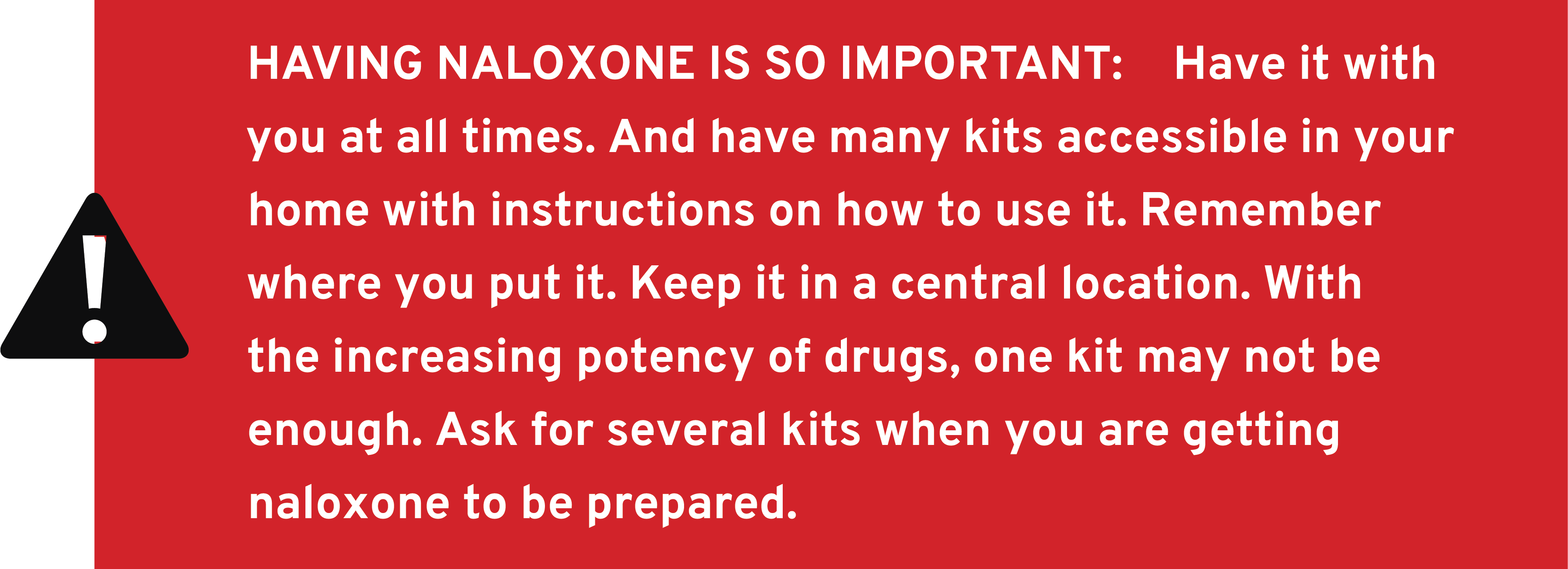Overdose/Drug Poisoning
Contents
NALOXONE
Naloxone (or Narcan ©) is a safe medication that temporarily reverses the effects of an opioid overdose. Naloxone works by temporarily removing the opioid off of the brain’s opioid receptors. If you suspect someone is overdosing, and you are unsure of what they have taken, you will do no harm by administering Naloxone.

WHERE TO GET NALOXONE
You can find out where to get Naloxone through: Algoma Public Health
Ontario Wide: Ontario Government
WHERE TO GET NALOXONE TRAINING
NaloxoneCare.com is an online learning portal to help individuals learn how to recognize the signs and symptoms of an opioid overdose and how to give Naloxone. You can get a free nasal naloxone kit once the training is completed.
ADDITIONAL RESOURCES
The Good Samaritan Drug Overdose Act protects you, the person who is overdosing, and anyone at the scene from being charged with:
- Possession of controlled substances (example, drugs)
- Breaches in pre-trial release, probation orders, conditional sentences, or parole related to simple possession
The Good Samaritan Drug Overdose Act does not provide protection against charges for:
- Outstanding arrest warrants
- Making and selling of controlled substances (example, drugs)
- All other crimes not outlined within the Act
For more information, visit the Government of Canada website.
SIGNS OF AN OVERDOSE
THE FOLLOWING ARE SIGNS OF AN OVERDOSE
-
- Loss of consciousness
- Unresponsive to outside stimulus
- Awake but unable to talk
- Breathing is very slow and shallow, erratic or has stopped
- For lighter-skinned people, the skin tone turns bluish-purple.
- For darker-skinned people, it turns grayish or ashen.
- Choking sounds or a snore-like gurgling noise (sometimes called the ‘death rattle’)
- Vomiting
- Body is very limp
- Face is very pale or clammy
- Fingernails and lips turn blue or purplish-black
- Pulse (heartbeat) is slow, erratic or not there at all
WHAT TO DO IN THE EVENT OF AN OVERDOSE
STEP 1. Stimulate them awake by yelling their name and administering a hard sternum rub to the chest plate.
STEP 2. Call 911, explain someone is not responsive and not breathing. They will talk you through the steps.
STEP 3. Provide rescue breathing. Get them on their back, tip their head back to straighten the airway, pinch their nose, put your mouth over theirs and form a seal. Give one breath every five seconds.
STEP 4. If you have naloxone/narcan, use it.
Administer one dose every two minutes:
-
- Injectable: Draw up the entire vial and inject into thigh muscle (this can be through clothes).
- Nasal: Stick the device all the way up one nostril and click the plunger, make sure the device is inserted fully (medication will absorb through the sinuses).
STEP 5. When they start to breathe regularly on their own, roll them into a recovery position on their side.
STEP 6. Be gentle with them and yourself afterwards! This is also not the time to talk with your young person about their substance use or the overdose. Overdose is a serious medical emergency, and the priority is medical treatment.
WE ENCOURAGE YOU TO PRINT THE ABOVE INFORMATION AND STICK IT ON YOUR WALL SOMEWHERE IN CASE OF AN EMERGENCY.
Every path is different for everyone; what might work for one person might not work for another; stay open minded.
SSM Parent Tweet

